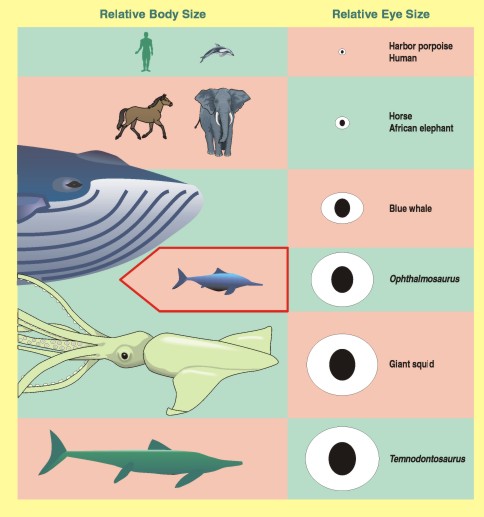Ichthyosaur Eyes
Ichthyosaur Eyes
a mirror of the content of Ryosuke
Degus's
excellent
webpage on Ichthyosaurs
in memory of Australia's ichthyosaur hunter Mary
Wade 1928-2005
2.2 EYES OF ICHTHYOSAURS
2.2.1 Eye Bones
You must be wondering how we can talk about the eyes of something
extinct. Well, the secret is what is called a sclerotic ring. This
doughnut shaped bone is embedded within the eyeball of most vertebrates,
except mammals (like us), crocodiles, and some others. Ichthyosaurs had
exceptionally well-developed sclerotic rings, as in the below
photograph, which is very good for us since we can take reliable
measurements off them.

The most commonly asked question about these bones is about their
function. In the 1950s, an observation was made that sclerotic rings
were particularly well-developed in the animals whose eyes were not
spherical. So it is believed that the ring helps keep the eyes in shape,
at least in some animals. Ichthyosaurs had very flattened eyeballs, so
it could well be that the sclerotic ring was useful in keeping the
eyeballs in shape.
There is another reason why shape-keeping may be necessary for
ichthyosaurian eyes. When a fish-shaped object moves forward in water,
some part of it is pushed by the surrounding water while the other parts
are pulled. It is usually the front part of the fish that is pushed most
strongly, and then there is no pull or push near the eye area (figure
below). As you go further posteriorly, the force changes to pulling by
the opercular area. So, for a fish, eye is located in a safe spot. In
ichthyosaurs, however, eyes are disproportionally large, as will be
discussed below. It is expected that the anterior part of their eyeball
be pushed while the posterior part is pulled just by swimming. So, it is
probably beneficial to have a bony structure in the eyeball to keep its
shape. This applies regardless of water depth.

2-2-2. Eye Sizes
You might have heard that ichthyosaurs had enormous eyes. Yes, it is
true. The largest ichthyosaurian eye that I've measured was 264 mm
across, and belonged to a Temnodontosaurus platyodon. This is the
largest eye ever recorded for any animal (when I wrote a paper in
Nature, the largest I had then was 253 mm). This measurement is
conservative, since the specimen is not entirely prepared.
You can appreciate how big the eyes are in ichthyosaurs by comparing eye
sizes among animals. See the figure below for example.

As can be seen in the figures above and below, there is another
ichthyosaur with the largest eye. Ophthalmosaurus is the beast. When
considering what scientists call relative growth, Ophthalmosaurus has
the largest eyes of all. The blue ichthyosaur shape indicates
Ophthalmosaurus in the figure below, where you can see it is far above
dinosaurs and even other ichthyosaurs.

2-2-3. Eye F-number
Another interesting thing about ichthyosaurian eyes is their f-numbers.
As you might know from camera lenses, f-numbers indicate the relative
brightness of optical systems. If the number is small, that means the
systems takes in more light. In cameras, you can shorten your shutter
speed by using more expensive lenses with lower f-numbers.
| Standard Camera Lenses (50 mm or so) | |
|---|---|
| Kind | Minimum f-number |
| Low End | f/3.5 or higher |
| Middle Class | f/2.8 |
| High End | f/1.0 to f/1.2 |
Eyes of animals have f-numbers too. It is known that nocturnal animals (night dwellers) have low f-numbers of about f/1.0, whereas diurnal animals (day dwellers) have relatively high f-numbers exceeding f/2.0. This is hardly surprising since nocturnal animals can use ability to collect extra light to enhance their vision.
| Animal Eyes | |
|---|---|
| Animal | Minimum f-number |
| Human | about f/2.1 |
| Owl | about f/1.1 |
| Cat | about f/0.9 |
| Ophthalmosaurus | f/0.8 to f/1.1 |
| Ichthyosaurus | f/1.1 to f/1.3 |
Using equations established in comparative ophthalmology, it is possible to estimate the f-number of ichthyosaurian eyes with ranges. It turned out that some fish-shaped ichthyosaurs, such as Ophthalmosaurus and Ichthyosaurus, had low f-numbers comparable to those of nocturnal animals. Other fish-shaped ichthyosaurs, such as Stenopterygius, had slightly higher f-numbers, whereas some lizard-shaped ichthyosaurs had much higher f-numbers comparable to human eyes.
see also... ICHTHYOSAURS INTRODUCTION FOREFIN EYES VERTEBRAE SIZE DIETS SWIMMING DIVING PHYLOGENY MARY WADE LITERATURE COPYRIGHTS back to Earth Science Australia...

